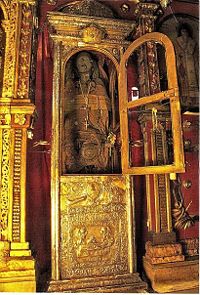Dionysius of Zakynthos
Our father among the saints Dionysius of Zakynthos was born in 1547 on the island of Zakynthos in the Ionian Sea. Before becoming a monk his name was Draganigos Sigouros. He was educated by priests and became fluent in Greek, Italian, and Latin. He excelled in theology, became a monk in 1568, received his first degree of ordination as a priest in 1570 as Daniel; he later became hieromonk of Zakynthos and Strofades. In 1577 he was raised to Archbishop of Aegina and Poros and after a year abdicated from this dignity and settled in Zakynthos as an abbot of a monastery. In December 17, 1622 he fell asleep in the Lord. He had asked to be buried in this monastery and his grave is still to be found in the chapel of St George; a dependent of the monastery.
It has been found that his body remains intact and emits a mixed fragrance of flowers and frankincense. Therefore he is venerated, and his sainthood has been proclaimed by the Patriarch of Constantinople. His feast day is celebrated on December 17, and on August 24, the Church celebrates the transfer of his holy relics.
Contents
"The Saint of Forgiveness"
St. Dionysius was remarkable in his forgiveness and love for his fellow man.
A man came to St. Dionysius's cell and begged the saint to hide him from his pursuers. When St. Dionysius asked him why he was being pursued, the man told him that he had killed a man. The murderer did not know that he had killed the saint's own beloved brother Constantine. St. Dionysius was very grieved but hid the man and did not surrender him to the law. Instead he instructed him and brought him to repentance. According to local tradition, the murderer later repented and became a monk himself at that same monastery.
St. Dionysius is an example to us all for his forgiveness of even the most grievous sins against us.
"The Wonderworker"
Dionysios grants his people many blessings; and many miracles are reported in connection with his ministry.
For example, when the Greek Orthodox Church of St. Nicholas was destroyed on September 11, 2001, during the World Trade Center attack, only two things were recovered intact: a cross and a paper icon of Dionysios.
"The Walking Saint"
Dionysius rests in the church which bears his name in Zakynthos, where opening his tomb is often found impossible. It appears as though this occurs when Dionysius is out performing miracles. Afterwards, when the tomb can be opened, seaweed is found at his feet and his slippers are found to be worn thin. In fact, his slippers need continual replacement because they receive so much wear. He is often seen alive and walking.
The other "Walking Saints" of the Ionian Islands
- St. Spyridon of Trimythous the Wonderworker from Corfu
- St. Gerasimos from Cephalonia
"Housing of the Relic"
In 1717, the monks, of the monastery of Strofades, moved the Saints relic and placed it inside the metochi [1] of Kalliteros in order to protect him from various destructive invasions by pirates in the area. At a later date, a church was built in his honour in the Ammos area and shortly converted into a monastery. Later, in 1764, the church of the monastery was rebuilt and in 1854 a steeple added to the church. In 1893, all this was destroyed by a major earthquake and a temporary church constructed to house the Saint until in 1925 there took place a foundation ceremony to rebuild an earthquake-resistant church; fully completed by 1948.[2] In 1953, when the next major earthquake hit the island, the church remained untouched and was used as a refugee for the homeless. Three years later, a new monastery was built to replace the ruins and has since been called "The Holy Monastery of Strofades and Saint Dionysios".
"The Larnaka"
Among the works of art inside the church of the Holy Monastery of Strofades and Saint Dionysios, stands the silver-sculptured "Larnaka" (grave) of the Saint. It was designed by a priest named Nikolaos Kantounis and depicts the dormition of Dionysios who is surrounded by many priests. It was made in 1829 by George Diamantis Bafas and is placed in a separate room to the church to the right of the Sacred Gate.
During the invasion of the pirates in 1717, both hands of the Saint were cut off by the pirates, however, due to a miracle did not manage to destroy his Holy Body. All of his relics are still kept in the larnaka.
Notes
- ↑ A building that belongs to a religious institution.
- ↑ The Church was designed by Anastasios Orlandos.
External links
Categories > Church History
Categories > Church History
Categories > Church History
Categories > Church History
Categories > Liturgics > Feasts
Categories > Liturgics > Feasts
Categories > Liturgics > Feasts
Categories > Liturgics > Feasts
Categories > People > Clergy > Bishops
Categories > People > Clergy > Bishops > Bishops by century > 16th-17th-century bishops
Categories > People > Saints
Categories > People > Saints > Greek Saints
Categories > People > Saints > Saints by century > 17th-century saints
Categories > People > Saints > Wonderworkers

